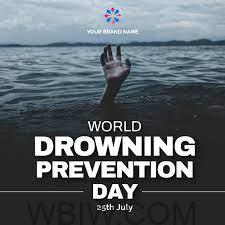
JACKSON CO. – Water activities are a big part of summer fun, but water poses serious danger and risk of injury or death. World Drowning Prevention Day is July 25.

According to the Centers for Disease Control and Prevention, drowning is the leading cause of death for young children. More children age one through four years old die from drowning than any other cause of death. For children ages five through 14 years old, drowning is the second leading cause of unintentional injury death.
Drowning disproportionately affects males, with 80% of drowning deaths occurring in males.

“We all enjoy swimming, boating, and other water-related activities,” said Sheriff Rick Meyer. “Unfortunately, every year people lose their lives by drowning.”
The CDC reports that there are an estimated 4,000 fatal drownings, an average of 11 per day, in the United States. There are 8,000 nonfatal drawings, an average of 22 per day.

Nonfatal drowning occurs when a person survives a drowning incident. However, these incidents can result in serious injuries, including brain damage or permanent disability.
“We often don’t consider nonfatal drownings and their long-term consequences,” said Sheriff Meyer. “It’s so important to always follow safety procedures each and every time you’re near the water.”
There are risk factors that make drowning more likely. These include:
- Not being able to swim.
- Missing or ineffective fencing around pools.
- Lack of close supervision.
- Location; most infant drownings occur in bathtubs and most children ages 1-4 drown in a home swimming pool.
- Not wearing life jackets.
- Consuming alcohol.
- Using drugs or prescription medication.
“There are definite risk factors that put individuals at much higher risk for drowning,” said Sheriff Meyer. “However, there are steps everyone can take to help prevent this terrible tragedy.”

Here are some water-safety tips from the American Red Cross and NSC:
- Don’t go into the water if you can’t swim. Swim lessons are available for all ages.
- Never swim alone.
- Supervise children when they’re in the water. The best practice is for adults to assume this responsibility by working in short shifts.
- Always wear a U.S. Coast Guard-approved life jacket appropriate for your weight and size. Always wear a life jacket while boating even if you know how to swim.
- Learn CPR and be aware of safe rescue techniques.
- Don’t jump in the water to save a friend. Go get help. You can also throw out a life preserver or other object that floats.
- Only swim where lifeguards are on duty. However, parents should still keep an eye on children even with lifeguards present.
- When visiting a water park, make sure you are tall enough and old enough before going on water rides. Don’t run – wet surfaces are slippery.
- Don’t dunk or push others. Don’t play breath-holding games.
- Be aware that rivers and lakes have currents and are very different from pools.
- Never consume alcohol when swimming, enjoying a hot tub or operating a watercraft, such as a boat or jet ski.
“Please be sure to use caution and play it safe around the water this summer,” urged Sheriff Meyer. “Water activities are enjoyable, but safety should always come first.”



